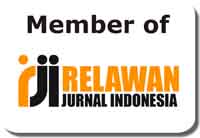Language Choices in Interracial Marriage: An Insight into Malay-Melanau Families in Sarikei, East Malaysia
Abstract
Keywords
Full Text:
PDFReferences
Antony-Newman, M. (2022). The role of plurilingual parenting in parental engagement of immigrant families. Journal of Multilingual and Multicultural Development, 1–17. https://doi.org/10.1080/01434632.2022.2097686
Arumugam, U. D. K. (1990). Masalah identiti golongan Sino-Indian di Malaysia. University of Malaya.
Aziz, Z. A., & Daud, B. (2016). Investigating the Language Choice of Acehnese Intermarriage Couples in the Home Domain. Banda Aceh, Indonesia Social Science.
Barron-Hauwaert, S. (2004). Language strategies for bilingual families: The one-parent-one-language approach. . Multilingual Matters Ltd.
Bezcioglu-Goktolga, I., & Yagmur, K. (2022). Intergenerational differences in family language policy of Turkish families in the Netherlands. Journal of Multilingual and Multicultural Development, 43(9), 891–906. https://doi.org/10.1080/01434632.2022.2036746
Creswell, J. W. (2013). Research design: Qualitative, quantitative, and mixed methods approaches. . Sage Publications.
Dava, E. (2021, prosinec 14). Ethnic mix-match couples are able to fit seamlessly into society. .
David, M. K. (2006). Language Choices and Discourse of Malaysian Families: Case Studies of Families in Kuala Lumpur. . Strategic Information and Research Development Centre.
Drury, T. P. R. (2001). Language Development at Home and School: gains and losses in young bilinguals. Early Years: Journal of International Research & Development, 21(2), 117–127. https://doi.org/10.1080/09575140125621
Dweik, B., & Qawar, H. (2015). Language choice and language attitudes in a multilingual arab canadian community: Quebec–Canada: a sociolinguistic study. British Journal of English Linguistics, 3, 1–12.
Grosjean, F. (2013). Bilingualism: A short introduction. . In F. Grosjean & P. Li (Ed.), The psycholinguistics of bilingualism (s. 5–21). Blackwell Publishing Ltd.
Harrison, G. J., & Piette, A. B. (1980). Young bilingual children’s language selection. Journal of Multilingual and Multicultural Development, 1(3), 217–230. https://doi.org/10.1080/01434632.1980.9994016
Holmes, J. (2013). An Introduction to Sociolinguistics. Routledge.
Hu, J. X. & N. S. T. (2019). Marriage and the family: Mirror of a diverse global society. . Routledge.
Chong, B. S.-Y. (2009). A note on Malaysians of mixed parentage. 46, 93–95.
Igboanusi, H., & Wolf, H.-G. (2010). The role of ethnically mixed marriages in language shift: a case study of Nigeria’s minority languages. Sociolinguistic Studies, 3(3), 451–464. https://doi.org/10.1558/sols.v3i3.451
ilanguages. (2018). Multilingual People.
Kadir, R. (2021). Language maintenance in an interracial marriage: the case of Indonesian females’ language choice in Canada. Indonesian Journal of Applied Linguistics, 11(1). https://doi.org/10.17509/ijal.v11i1.34589
Karpava, S., Ringblom, N., & Zabrodskaja, A. (2018). Language Ecology in Cyprus, Sweden and Estonia: Bilingual Russian-Speaking Families in Multicultural Settings. Journal of the European Second Language Association, 2(1), 107. https://doi.org/10.22599/jesla.41
Lim, C. (2008). Language choices of Malaysian youth: A case study. Universiti Malaya.
Malavé, L. M. (b.r.). Developing Bilingualism in Children Parent Characteristics: Influence in the Development of Bilingualism in Young Children.
Mathew, J. (2019, duben 25). Half of the world is bilingual. What’s our problem? The Washington Post.
MyGovernment. (2021). Demography population.
Ng, B. C., Tan, M. J. J., Pauwels, A., & Cavallaro, F. (2022). Language practices in Malay-Chinese families in Singapore. Journal of Multilingual and Multicultural Development, 1–21. https://doi.org/10.1080/01434632.2022.2080214
Pue, G. H., & Sulaiman, N. (2013). „Choose one!": Challenges of inter-ethnic marriages in Malaysia. Asian Social Science, 9(17), 269–278. https://doi.org/10.5539/ass.v9n17p269
Rozana, A., Zaid, M., & Mee, M. Y. (b.r.). The Language Choice Among Chinese-Indian Mixed-Marriage Families in Malaysia.
Samat, N., Mahamud, M. A., Abdul Rashid, S. M. R., Elhadary, Y., & Mohd Noor, N. (2019). Urbanisation beyond its core boundary and its impact on the communities in george town conurbation, Malaysia. Planning Malaysia Journal, 17(10). https://doi.org/10.21837/pmjournal.v17.i10.627
Sarikei Divisional Administration. (2022). Demography.
Shen, C., & Jiang, W. (2021). Heritage language maintenance and identity among the second-generation Chinese-Australian children. Bilingual Research Journal, 44(1), 6–22. https://doi.org/10.1080/15235882.2021.1890650
Schmidt-Mackey, I. (1971). Language Strategies of the Bilingual Family. . In W. F. Mackey & T. Anderson (Ed.), Bilingualism in Early Childhood (s. 132–143). Newbury.
Schwabe, M., & Weziak‐Bialowolska, D. (2022). Migrant networks, information flows and the place of residence: The case of Polish immigrants in the UK. International Migration, 60(4), 193–208. https://doi.org/10.1111/imig.12924
Tuah, D., Shin, C., Gedat, R., & Jazlan, M. (2021). The Language Ecology of the Kedayan in Sarawak: A Quantitative Survey on Language Sustainability. Ecology, Environment and Conservation, 27, 33–38.
Yamat, H., Umar, N. F. M., & Mahmood, M. I. (2014). Upholding the Malay Language and Strengthening the English Language Policy: An Education Reform. International Education Studies, 7(13). https://doi.org/10.5539/ies.v7n13p197.
DOI: http://dx.doi.org/10.31332/lkw.v0i0.6500
Copyright (c) 2024 Gelson Peter, Dexter Sigan John, Feona Albert Abell, Keezrawati Mujan Yusuf

This work is licensed under a Creative Commons Attribution-ShareAlike 4.0 International License.
Langkawi: Journal of The Association for Arabic and English indexed by:



















.png)
.png)

.png)
2.png)








